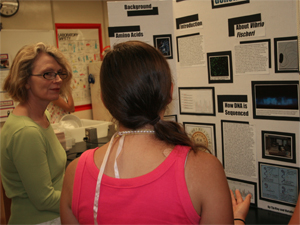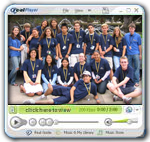UC San Diego Summer Science Program for High School Students Expands Enrollment
March 16 Deadline for COSMOS @ UCSD
San Diego, CA, March 8, 2006 - For the second year in a row, the Jacobs School of Engineering is organizing and Calit2 is supporting UCSD participation in a widely-praised state program that gives talented high school students a taste of college life. Applications for the 2006 California State Summer School for Mathematics and Science (COSMOS) are due March 16 for the month-long program that starts July 9.
|
UCSD is the fourth UC campus to participate in COSMOS, which originated on the UC Irvine campus, and later expanded to Davis and Santa Cruz. In its 2005 inaugural summer, the UCSD program enrolled more than 80 students.
"This year we have room for 120 students, and next year that number will jump to 150," said Susan Kelly, director and organizer of COSMOS @ UCSD. "In order to accommodate the larger enrollment without jeopardizing our twelve-to-one student-teacher ratio, we are also boosting the number of clusters around which the academic and research experience is built."
Each cluster is based on a theme, and the five clusters that debuted in 2005 are available again this year [click on names for full descriptions]: Adventures in Media Computing, Kinetic Sculpture & Clocks, Living Oceans & the Impacts of Climate Change, Earthquakes in Action, and the Molecular Biology Revolution. For summer 2006, the two new clusters are Physics of Waves & Stars, and Bioengineering and Modeling of the Red Blood Cell Membrane .
Because the COSMOS program is open to students as early as those completing eighth grade this year, the clusters have varying entry requirements. The computing cluster requires that students have completed Algebra II, while the physics group requires Algebra I (but recommends trigonometry). The 'kinetic sculpture' cluster for students interested in mechanical engineering requires one year of physics, while the biology and bioengineering clusters both require one year of high-school biology. And the oceans-and-climate cluster organized by Scripps Institution of Oceanography professors Kathy Barbeau and Andrew Dickson has a non-academic requirement: students must know how to swim!
|
Structural Engineering professor P. Benson Shing will oversee the earthquake engineering group (with the "geophysics of earthquakes" component led by Scripps postdoctoral researcher Bridget Smith). Mechanical and Aerospace Engineering (MAE) professor Raymond de Callafon will conduct the kinetic-sculpture cluster, while MAE professor Robert Skelton and Bioengineering professor Amy Sung share responsibility for the bioengineering group.
Tuition for 2006 is $2,000 for California residents, which includes housing in new dorms at Eleanor Roosevelt College, transportation, field trips, classroom materials and meals on campus. (For out-of-state students, tuition is $6,200.) Last summer approximately one-third of the students who attended the program received full financial aid, thanks to support from sponsors including QUALCOMM Incorporated, Toyota USA Foundation, Legler Benbough Foundation, John Moores Foundation, SAIC, and Calit2.
"One of the primary missions of COSMOS is to create a community of student scholars and a climate that fosters analytical thinking and experimentation," said organizer Kelly, noting that all students are required to do research and complete a team project related to their cluster theme. "We also want to expose these talented teenagers to the rich culture of learning on the campus and, hopefully, give them an extra reason to come back to UCSD and the Jacobs School when it comes time to apply for college."
Apart from the intensive classroom work and field trips related to each cluster's theme, COSMOS students as a group will hear from renowned scientists and engineers on a wide range of research topics. The talks are designed to expand students' learning outside of their cluster topics. Organizers also plan a series of workshops on related topics, including UC admissions, financial aid, and careers in science.
Related Links
COSMOS@UCSD
Applying to COSMOS
COSMOS
COSMOS Program Ends on a High Note for High School Students at UCSD
UCSD Launches Residential Summer Academic Program (May 2004)
Media Contacts
Media Contact: Doug Ramsey, (858) 822-5825, dramsey@ucsd.edu



